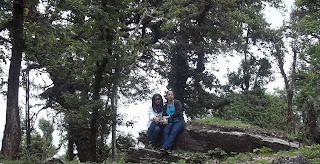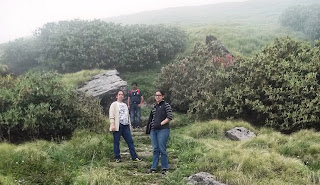Indians date their history from the Vedic Period.This is the period when the Vedas, the oldest and holiest books of Hinduism, were compiled. There has been a great dispute for the last 150 years, over dating of Vedic period based on the 'Aryan Invasion Theory', which claims that Vedic people came from Europe / Central Asia and spread their language & culture among ancient Indians. The earliest archaeological traces are from archeological findings of 7000 BC Mehrgarh, Balochistan, Pakistan which grew in advanced, planned urban towns of the "Indus Valley Civilization". This civilization peaked around 3300 BC before declining and disintegrating around 1900 BC, possibly due to a drought & geological disturbances. The excavations reveal an extremely advanced urban civilization, with no evidence of weapons or fortifications.
The Vedic civilization influences India to this day. The roots of present-day Hinduism lie in them. Some rituals of Hinduism took shape during that period. Most North-Indian languages come from Sanskrit, the language of the Vedas. These languages together with Sanskrit are members of the Indo-European group of languages. In the 1st millennium BC, various schools of thought in philosophy developed, enriching Hinduism greatly. Most of them claimed to derive from the Vedas. However, two of these schools - Buddhism and Jainism - questioned the authority of the Vedas and they are now recognized as separate religions.
Pilgrims bathing,
VaranasiMany great empires were formed between 500 BC and AD 500. Notable among them were the Mauryas and the Guptas (called the Golden Age). This period saw a gradual decline of Buddhism and Jainism. The practice of Buddhism, in particular, disappeared from the Indian mainland, though Buddha himself was incorporated into the Hindu pantheon. Jainism continues to be practised by a significant number who are ambivalent about whether they consider themselves Hindus or not.
Islamic incursions started in the 8th century in the form of raids. Gradually the raiders started staying as rulers. Soon much of North India was taken over by Islamic rulers. The most important of the Muslim rulers were the Mughals, who established an empire that at its peak covered almost the entire subcontinent except the southern and eastern extremities. The major Hindu force that survived in the North were the Rajputs. Eventually the Mughal empire declined, partly under attack from the Marathas who established a short-lived confederacy that was almost as big as the Mughal Empire. The Rajput and Mughal period of North India was the golden age for Indian art, architecture, and literature. It produced the monumental gems of Rajasthan, and the most famous monument of all, Taj Mahal. Two languages, Hindi and Urdu, took root in medieval North India. During the Islamic period, some Hindus also converted to Islam, either by force, or to escape the low social status that the caste system imposed on them, or to gain the benefits of being aligned with the then rulers. Today, some 13% of the Indian population and an overwhelming majority of Pakistan is Muslim.
South India followed a different trajectory, being less affected by the Islamic invasion. The period from 500 AD to 1600 AD is called the classical period dominated by great South Indian kingdoms. Prominent among them were the Chalukyas, Rashtrakutas and Vijayanagar empire who ruled from present day Karnataka and the Pallavas, Cheras, Pandyas and Cholas who ruled from present day Tamil Nadu & Kerala. Original literature in
Tamil,
Kannada and
Telugu flourished during this time and has been prolific ever since. Some of the grandest Hindu and Jain monuments that exist in India were built during this time in South and East India, which were less subject to religious prohibitions on them.
European traders started visiting India beginning in the late 16th century. By the 19th century, the British East India Company had, one way or the other assumed political control of virtually all Indian lands. There was an uprising by Indian rulers in 1857 which was suppressed, but which prompted the British government to make India a part of the empire. Many Indians converted to Christianity during the period, for pretty much the same reasons as they converted to Islam, though forcible conversions ended in British India after 1857, when the British Government took over from the East India Company, and Queen Victoria promised to respect religious faiths of Indians.
Non-violent resistance to British colonialism under Mohandas Karamchand Gandhi and Jawaharlal Nehru led to independence in 1947. However, independence was simultaneously granted to the secular state of India and the smaller Islamic state of
Pakistan, and the orgy of Hindu-Muslim bloodletting that followed Partition led to the deaths of at least half a million and the migration of 12-14 million people.
Free India under Nehru adopted a democratically-governed, centrally-planned economy. These policies were aimed at attaining "self-sufficiency", and to a large extent made India what it is today. India achieved self-sufficiency in food grains by the 1970s, ensuring that the large-scale famines that had been common are now history. However these policies also led to shortages, slow growth and large-scale corruption. After a balance-of-payments crisis in 1991, the country adopted free-market reforms which have continued at a meandering pace ever since, fueling strong growth. IT and Business Process Outsourcing industries have been the drivers for the growth, while Manufacturing and Agriculture, which have not experienced reforms, are lagging. About 60% of Indians live on agriculture and around 25% remain in poverty.
Relations with Pakistan have been frosty. They have fought three (or four, if you count the Kargil conflict of 1999) wars, mostly over the status of
Kashmir. The third war between the two countries in 1971 resulted in East Pakistan becoming
Bangladesh.
China and India went to war in 1962 over a border dispute. Viewed as a "betrayal" in India, it still rankles. Though current relations are peaceful, there is still military rivalry and no land crossings between the countries. The security concerns over Pakistan and China prompted India to test nuclear weapons twice (including the 1974 tests described as "peaceful explosions"). India wants to be accepted as a legitimate nuclear power and is campaigning for a permanent Security Council seat.
India is proud of its democratic record. Constitutional government and democratic freedoms have been safeguarded throughout its 60 years as an independent country, except for an 18 month interlude in 1975-1977, when Prime Minister Indira Gandhi declared a state of emergency, suspending elections and civil liberties.
Current concerns in India include the ongoing dispute with Pakistan, over-population, corruption, environmental degradation, continuing poverty, and ethnic and religious strife. But the current obsession, at least among the educated elite, is over whether India will be able overtake China in economic growth.




